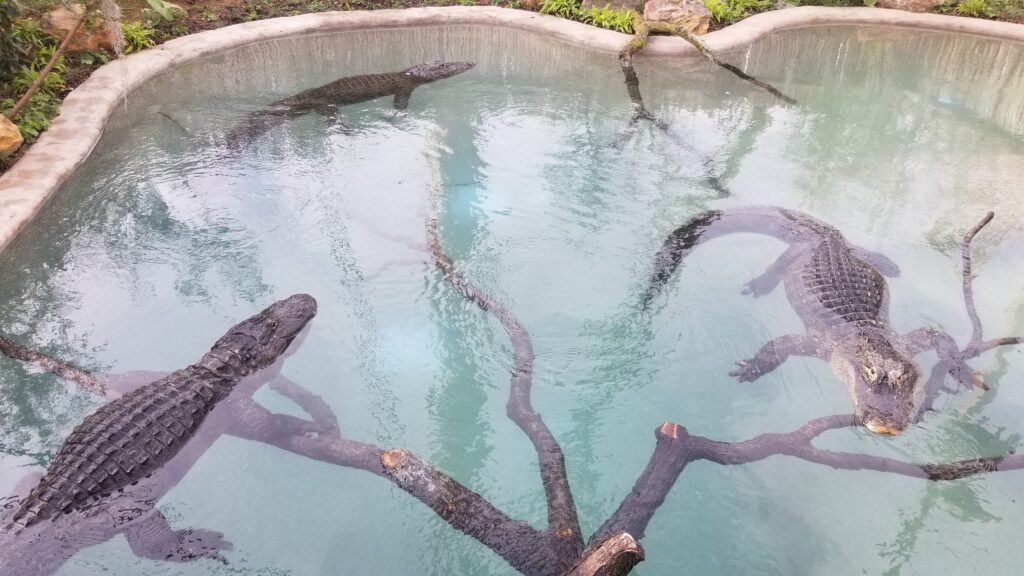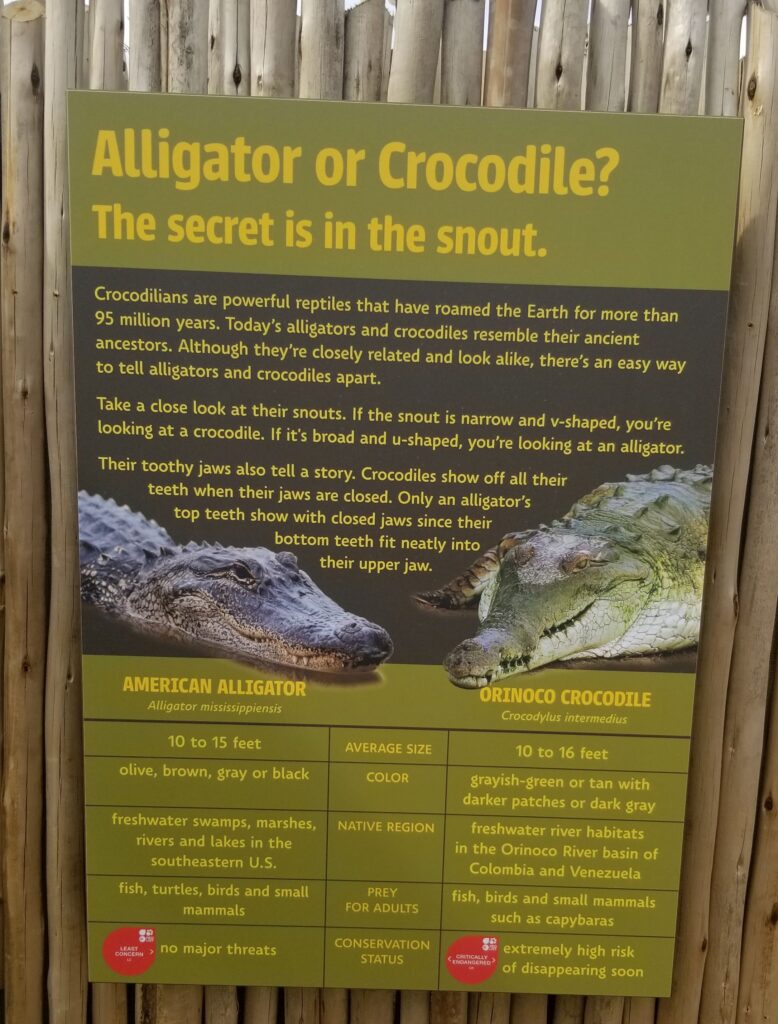VISIT ‘ALLIGATOR ALLEY’ & ‘CROCODILE CORNER’… IN INDIANAPOLIS
By Mike May
Go Gators! That may be the ‘battle cry’ for sports fans of the University of Florida, but it’s also an appropriate new slogan for anybody planning an upcoming visit to the Indianapolis (Indiana) Zoo. Thanks to the recent arrival of a few reptiles – specifically, American alligators and Orinoco crocodiles — the Indianapolis Zoo is now officially ‘Gator & Crocodile Country.’ It has quickly become a big draw for fans of those scaly reptiles. As you would expect, the alligators and crocodiles now living at the Indianapolis Zoo are not native Hoosiers as they were born and raised in far warmer climates. Both the alligators and the crocodiles hail from St. Augustine, Florida, though, if you want to see Orinoco crocodiles in the wild, you will have to travel to South America, specifically to Columbia and Venezuela.

On Wednesday, May 26, the Indianapolis Zoo’s new reptile exhibit – Alligators & Crocodiles: The Fight To Survive presented by Central Indiana Honda Dealers – opened to a select gathering of zoo supporters, local dignitaries, and the media. Three days later, on May 29, this new reptilian exhibit opened to the general public. The initial interest from visitors has been strong as many people in Indiana and throughout the Midwest, for that matter, have never seen a living, breathing alligator or a crocodile.
“It’s amazing to see those alligators on display at the zoo,” said Catherine Barkes Bowie of Indianapolis. “What’s incredible is how small the juveniles are and how big they become as adults.”
“Those reptiles look like prehistoric creatures,” says Susie Bixler of Greenwood, Indiana. “When they want to move, they move quickly – in and out of the water. Wow!”
Besides giving the Indianapolis Zoo another new exhibit for the general public to see, the biggest reason why the zoo opened its doors to these one-of-a-kind reptiles is because alligators were once on the endangered species list and crocodiles remain on the comeback trail.
Fortunately, alligators are now thriving in the wild and have been since 1987, thanks to the Endangered Species Act. According to Indianapolis Zoo officials, by having alligators living at the zoo, it helps to celebrate and publicize the revival of the species as millions of alligators currently live in the swamps, marshes, bayous, ponds, lakes, and rivers in the southeastern section of the U.S. And, now, a few of them are living in Indianapolis in an environment that has been built to emulate, replicate, and simulate what they are used to ‘back home’ in the southeastern section of the U.S.

Unfortunately, Orinoco crocodiles remain on the endangered species list and are one of the world’s most critically endangered reptiles. According to Indianapolis Zoo officials, there are less than 260,000 adult Orinoco crocodiles remaining in the wild. The declining population of this species of crocodiles is largely due to excessive hunting and a loss of their natural habitat. These crocodiles are native to the Orinoco River basin in Columbia and Venezuela. Believe it or not, but these crocodiles are the third largest species of crocodilian and the largest species in the Americas. And, it’s worth noting that crocodilians have been in existence for more than 200 million years. With their scaly, armored bodies, sharp teeth, and massive tails, they closely resemble the dinosaur relatives that they have outlived.
“We do support conservation efforts of Orinoco crocodiles through the Venezuelan Crocodile Specialist Group,” said Carla Knapp, a public relations specialist for the Indianapolis Zoo.
Right now, there are seven alligators at the Indianapolis Zoo – three adult males and four juveniles. It’s possible that the adult males will grow to be 10-15 feet long and weigh anywhere from 200 to 800 pounds. And, the four juveniles – which are roughly 18 inches long – are cute, but not cuddly. But, they each have a cute name: Champ, Chomp, Swamp, and Snapper. The three adult males are named Carl, George and Louis. Their names are inspired by the states within alligators’ native range in the U.S. Those three states are South Carolina for Carl, Georgia for George, and Louisiana for Louis.
The crocodile habitat is the indoor area that is next to the alligator exhibit. The two crocodiles are named Nicole and Christie.

According to Knapp, the crocodiles are a little more shy than the alligators and they tend to stay in their own pool.
“Nicole has started coming out to the yard for a few hours each day to bask in the sunshine and we hope both animals will come out more as they get more accustomed to being around our guests,” added Knapp.
When you come to the Indianapolis Zoo, you’ll be able to get very close to these unique reptiles.
Visitors can see these massive adult animals up close in a lush, outdoor habitat and even touch juvenile alligators during daily Wild Encounter interactions.
The one thing that the gators and crocs won’t have to do is hunt for their own food. The Indianapolis Zoo is providing free meals for their creatures from the swamp. In the wild, they are used to eating fish, turtles, small mammals, frogs, birds, and small reptiles. Believe it or not, but adult alligators will eat baby alligators, if they are hungry enough.
The adult alligators are being fed three times each week. They will be fed a varied diet of rats, chicken, quail, fish, and a specially formulated alligator pellet.
The crocodiles are fed twice per week and they eat fish, primarily, along with rats, chicken, quail, and a specially formulated crocodile pellet.

The juvenile alligators are fed three times a week. Their diet includes earthworms, cockroaches, fish, small rodents, and alligator pellets.
While the gators and crocs will have no problem adjusting to outdoor life in Indianapolis during the late spring, summer, and early fall, the Indianapolis Zoo has gone to great lengths to keep those big reptiles comfortable during the cold and, at times, frigid winter months in Indianapolis.
The goal is to keep the alligators outside during the winter, floating in the water. To make this possible, the water temperature in their pond will be maintained at 65 degrees throughout the year so they can cope with any frigid winter-time lows. The pool for the crocodiles will be maintained at 78 degrees, year round.
So, in addition to the lions, tigers, bears, and giraffes, a trip to the Indianapolis Zoo will now include a chance to visit ‘Alligator Alley’ and ‘Crocodile Corner’ without having to venture into a swamp or a bayou in the Deep South.
You are encouraged to come to Indianapolis to see for yourself.
Just as the Indianapolis Motor Speedway is the home of the ‘Greatest Spectacle in Racing,’ the Indianapolis Zoo is also now the home of another one of the city’s ‘Greatest Spectacles:’ nine reptilian spectacles, to be precise: Carl, George, Louis, Champ, Chomp, Swamp, Snapper, Nicole, and Christie. They all await your arrival.
As they are now saying in Indianapolis, “See you later, alligator.” And, “after a while, crocodile.”

